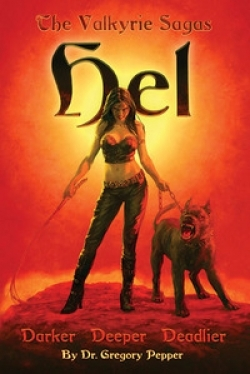The Valkyrie Sagas
Volume Two: Hel
Fantasy often weaves psychological and social ideas into an imaginative story. Author Dr. Gregory Pepper, a U.K. medical doctor writing his first series, uses ancient Norse legends to work magic in the genre. In his second installment, The Valkyrie Sagas: Hel, Pepper creates a multitude of plots with fascinating characters, both living and dead. Some inhabit Midgard—Earth, while other souls are sent to Asgard, where the gods and Valkyries live. The damned reside in Hel, and only those with strong stomachs should read Pepper’s rendition of it. He describes a waste disposal site of dead bodies, which “…facing the sun was alive, seething with a living carpet of black poppies, rotting flesh, foul insects, and giant maggots.”
Hel, as named in the book’s title, is the sadistic queen of those eternally punished. The banished goddess either throws her captives into pits of boiling refuse or subjects them to her nightmarish sexual whims. She longs for absolution from Odin, king of the gods, but if her plans fail, she will wage all-out war against him.
Pepper explains recurring characters so the initial installment is not a prerequisite. Kat is a Valkyrie warrior, angry about having been murdered, thus denied a life on Midgard as a doctor. Marcus, the detective who investigated her case, gets involved with evil forces on Midgard that harbor vendettas against Odin. Marcus falls in love with a Valkyrie who has come to Earth; then he uses his wife for cover.
Many scenes explore 21st century mores: warriors train peasants of a country to fight, which strengthens the outcome for the aggressor; there is noticeable climate change—one Valkyrie come to earth blames humans; the pizza tastes bland and processed. Hel has a satirical view of Christians: it is against their religion to fight but they do have an attitude toward other religious followers, especially those of Mohammed. She cannot “…understand why they all didn’t just get along together.”
Although acts of violence and sex are raw and explicit, and some readers may wish for fewer graphics, many beautifully written scenes provide relief: the descriptions of colors in a sky; sounds of a rushing river, the snowy stillness of a plateau. Pepper maneuvers plot-turns while keeping track of foreign universes and the aliases and nicknames of his shape-shifting characters. Readers will appreciate the humor while recognizing that Norse mythology has representative ruthlessness and fake charmers much like in Roman, Greek and Native American legends. Clichés like “…a Kodak moment,” and “Yadda, yadda, yadda…” lend to the notion of this series as a parody of current life. The book ends with a twist that leads to the beginning of the next volume. It’s worth the wait.
Reviewed by
Mary Popham
Disclosure: This article is not an endorsement, but a review. The publisher of this book provided free copies of the book and paid a small fee to have their book reviewed by a professional reviewer. Foreword Reviews and Clarion Reviews make no guarantee that the publisher will receive a positive review. Foreword Magazine, Inc. is disclosing this in accordance with the Federal Trade Commission’s 16 CFR, Part 255.

